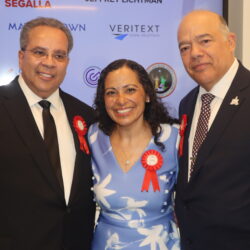
Annual BHA Meeting Proves Unusually Entertaining
By Henrik Krogius
The annual public meeting of the Brooklyn Heights Association, held at St. Francis College last week Wednesday evening, was less devoted to serious topics and more to entertainment than usual.
Channel 13’s perennial awards presenter, Tom Stewart, sandwiched a running quiz about the anticipated fate of “Downton Abbey” characters between his award announcements, and many in the well-filled Founders Hall lustily shouted answers.
Featured speaker Sam Sifton, the former restaurant critic and now the national editor of the New York Times, regaled the audience with stories about his Brooklyn Heights youth and comments about places serving good, honest food.
The one serious matter that really engaged many in the hall involved pedestrian safety, especially on Montague Street, in terms both of cars making turns against lights or stop signs and bicyclists riding on sidewalks or against traffic. Many suggestions were offered. Note was taken of at least some of these.
The auditorium with its wide front wall allowed for the projection of large photographs of Heights subjects, as well as one traffic diagram and a photo of a table with a plate of food, above the speakers. After the routine preliminaries of a brief treasurer’s report and election of new board members, Jane McGroarty, president of the BHA, ran down issues of local concern. She welcomed the plan for improving pedestrian access to Brooklyn Bridge Park at Atlantic Avenue, and she voiced the hope that critics of the BHA’s successful lawsuit against conversion of the Tobacco Warehouse for a theater company would come around once the site is again open for public events.
Standing below a greatly enlarged photograph of the 75 Livingston Street tower that initially appeared on the cover of the Feb. 9 Brooklyn Heights Press, Ms. McGroarty praised the designation of the downtown skyscraper district before going on to criticize the Landmarks Preservation Commission for not demanding a more interesting, contemporary design for the 5-story apartment building at 30 Henry Street hat is replacing the recent home of the Brooklyn Daily Eagle. She also reiterated the BHA’s stand opposing new construction at the Heights Cinema site, saying the building contains historic detail that warrants its preservation.
Following Tom Stewart’s award presentations (see sidebar story), Sam Sifton remarked that if he could talk as well as Tom he would go on forever. But then he went on to prove he could talk no less easily and just as humorously. “Everybody is interested in food, even those who say they aren’t,” he said by way of justifying his main topic, and the crowd’s response clearly corroborated that. But before going further, he recalled what he said were the more dangerous years in the Heights of the 1970s when muggings were quite frequent and it was important for a youngster to know an escape route from threatening gangs.
As to food, Sifton began with local diners and pizza. “Your first pizza forever determines your judgment of pizza,” he said. He mentioned his early experience with the slices at Fascati (on Henry Street) and Queen (on Court Street). “Fascati IS pizza,” he declared. He went on to remark on various restaurants in both Brooklyn and elsewhere (the South is now the trendsetter in cooking, he thought), and he described the importance of the critic’s role by drawing a parallel with art. “Artists are often the worst at explaining their art,” he said. “Critics decode the artists.”
Ms. McGroarty finally had to bring to an end the questions that followed.
The Awards
The Heights Association recognized a hospital and a police commander with community service awards, and two outstanding restoration projects for their architectural merit.
The merged Long Island College Hospital/SUNY Downstate was cited for, in presenter Tom Stewart’s announcement, “forming a renewed center of medical excellence, and confirming the institution’s dedication to serving the people of Brooklyn through its three-fold mission of education, research and patient care.” On hand to accept the award were Dr. John LaRosa, president of the SUNY Downstate Medical Center, and Deborah Carey, CEO of the combined hospital.
Deputy Inspector Mark DiPaolo, commanding officer of the 84th Precinct, was applauded for quickly becoming “a member of the community” upon his assignment. Stewart noted that DiPaolo had officers patrolling the streets and introducing themselves to Heights residents, meeting personally with local organizations, learning the habits and routes of local schoolchildren so that their safety might be ensured, and responding quickly in rare instances of violent crime.
(During a later question period, DiPaolo fielded a host of questions and complaints about infractions by drivers and cyclists. On suggestions for cameras at traffic lights and the installation of speed bumps, he pointed out that such decisions rested with the city and its department of transportation, not his precinct, and that potential negative consequences such as rear-end collisions also had to be factored into the decisions. But he said he was trying to balance the deployment of available police officers between crime prevention and traffic enforcement.)
The remarkable transformation of 58 Hicks Street from an asbestos-shingled eyesore to its original frame-house elegance won an award for excellence of architectural restoration for owners Jeremy Lechtzin and Amy Klein. “Once the homeliest house on the block,” Stewart said of the house whose oldest section dates to 1814, “it is today one of the most attractive in the area.”
Projected ‘before and after’ photographs dramatically illustrated the improvement.
An especially unusual restoration involving 177-179 Columbia Heights prompted another architectural award, to the board of that building for having “labored for years to obtain the necessary financing for the project and persevered against many challenges to do the right thing.” The problem was how to recover the incised sgraffito ornamentation “including fruit garlands, winged horses and spiraling ribbons” [Stewart didn’t mention the devils in the doorways] that had been painted over and largely lost. Called in by the board were Gabriel and Lucia Popian, “perhaps the only artisans in the metropolitan area who are familiar with the technique and who could restore it.” Joseph Levine accepted the award on behalf of the board.
— HK
Leave a Comment
Leave a Comment




